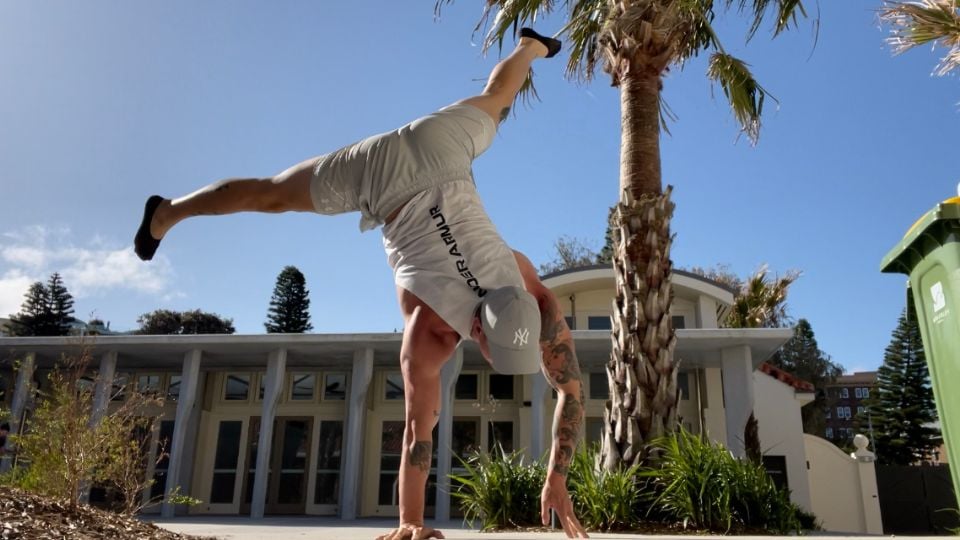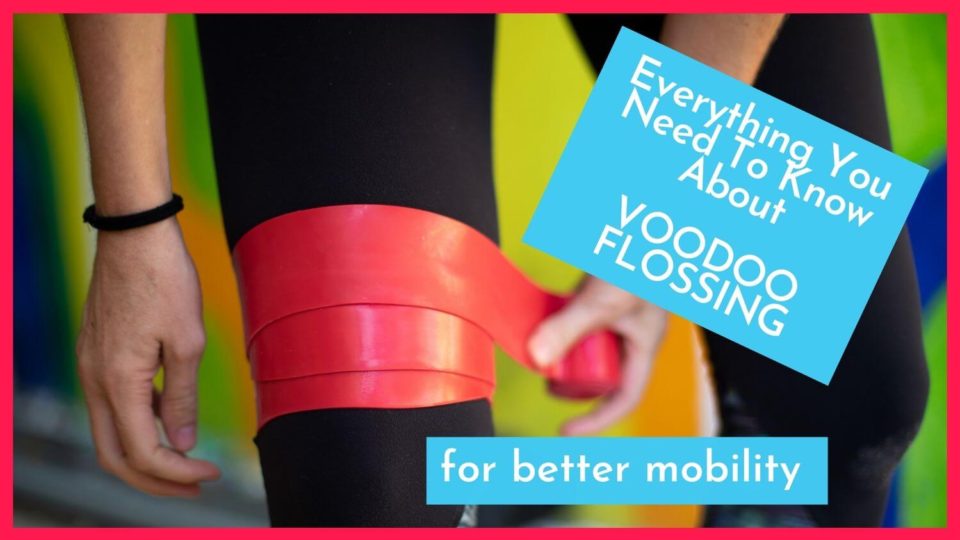Voodoo flossing, also known as tissue flossing, is a great option to consider as part of your mobility training plan. Physical therapists and fitness enthusiasts alike often use voodoo floss as one of their mobility tools.
Read on to learn everything you need to know about how tissue flossing works, safety considerations, and exercises for each body part.
(This post includes affiliate links for which I may earn a commission at no extra cost to you should you make a purchase)
An introduction to tissue flossing
Also known as voodoo tape, compression tack, or mobility bands, voodoo floss has nothing to do with creepy dolls or spells (to my knowledge, anyway!). They’re also entirely unrelated to the floss dance!
Although the elastic bands may resemble exercise resistance bands, they’re used for a different purpose and in a completely different way.
Voodoo flossing is sometimes referred to as joint flossing, muscle flossing, compression tissue flossing, or compression band therapy (CBT). Although you might hear the term “blood flow restriction training (BFRT)” used interchangeably, it is not the same as voodoo flossing. They are related modalities, but a specific type of cuff should be used for BFRT, and the goals differ from those of voodoo flossing.
In this post, you’ll learn about tissue flossing, how it works, and why you might consider using it. You’ll learn how to use it for specific body parts, about safety concerns, research, and where to buy voodoo floss.
If you’re still keen to learn more about mobility training techniques by the end of the post, I’ll tell you about another very effective and complementary technique to muscle flossing.
With over 600 pre-recorded classes (as well as live sessions) to choose from, I highly recommend the FIIT at-home workout app. They have a whole section just for mobility-specific classes.
Get 10% off any membership on Fiit using code ELLY10
What is voodoo floss, and what does it do?
Voodoo floss (also known as compression tack) refers to the tape used for muscle and joint flossing. It’s a long band that you wrap around a specific area on the arm or leg. It acts like a compression bandage.
Once the body part is wrapped up, blood flow to the area is restricted, and specific exercises or stretches are performed. After a short time, the band is removed to allow blood to flow back into the area.
Voodoo bands are often made from latex rubber, although latex-free options are also available. They are often used in CrossFit mobility WOD training. Some physiotherapists, chiropractors, physical therapists, and fitness trainers might also use them as part of their toolkit.
Tissue flossing could be used in conjunction with trigger point therapy techniques and tools such as foam rollers and trigger point balls. Whereas the focus of trigger point therapy is on the muscles, voodoo flossing can also work into the joints, so these offer promise as complementary mobility training techniques.
You may have also heard about massage guns, which are another related modality that uses a technique called percussive therapy.
How and why does voodoo floss work?
Overall, it’s not clear exactly why voodoo floss works. What’s known is that tissue flossing, like other mobility techniques, is a form of myofascial release that results from the interaction between the nervous system and muscles. When used around a joint, it may help temporarily create space in the joint and, in turn, reduce joint compression and movement restrictions.
A few theories explain how voodoo floss works, but more research is needed to understand its mechanism. The term “flossing” likely comes from the analogy of flossing teeth. The theory is that muscle flossing helps break up the “junk” between muscles.
Blood flow is temporarily restricted when the band is in place and then returns to the joint or muscle when it is removed. Theoretically, circulation increases after the band is removed, which has the potential to aid in healing and recovery. Some people claim this helps break down scar tissue, but this has not been proven.
Tissue flossing is very different from wearing compression clothing. Voodoo floss is only left on for a very short time, creating a much tighter, deep compression effect. Other compression tools may be used for longer periods at a time. However, they work differently from voodoo flossing and may offer intermittent rather than continuous compression.
What is voodoo floss used for | Voodoo flossing benefits
Why use voodoo floss? The main aims and potential beneficial effects of tissue flossing include:
- Improving joint range of motion.
- Increasing mobility (i.e., improving movement/being able to move more freely and easily).
- Reducing fascial restrictions.
- Potential improvements to athletic performance.
- Decreasing muscle and joint pain.
- A recovery tool to use after workouts or between training sessions for reducing delayed onset muscle soreness (DOMs).
- Reducing injury potential during workouts when it’s used for pre-workout mobility.
Voodoo floss is used on specific areas of the limbs based on previous sports injuries, niggles, or general areas of stiffness or pain (e.g., ankle or knee pain).
Does tissue flossing really work?
Studies on the effects of tissue flossing are limited and small-scale. The results of some of these studies highlight the potential of voodoo floss as an effective tool for injury prevention and athletic performance (such as sprint performance). Overall, more research is needed to draw solid conclusions.
A study of 52 recreational athletes found that voodoo flossing the ankle increased dorsiflexion and plantarflexion range of motion. It also improved single-leg jump performance compared to the control (non-flossed) ankle. A meta-analysis of studies on tissue flossing for ankle joint range of motion also identified some positive results.
Other studies have found no significant improvements in range of motion when comparing tissue flossing to a control group. In a study of glenohumeral flexibility (shoulder range of motion), no statistical difference was found between the voodoo flossing and non-voodoo flossing groups.
Interestingly, the floss group perceived an increase in flexibility. Therefore, the effects were psychological rather than physical!
Another study of 59 participants found no significant improvement in gastrocnemius length (calf flexibility) with voodoo flossing compared to a standard stretch. This study may have had several limitations, including the method of testing (static stretching).
Most advocates of voodoo floss are probably more likely to use it when performing dynamic stretch movements, mobility-specific movements, or bodyweight resistance exercises.
If you ask a regular flosser, “Do voodoo floss bands work?” They’ll likely give you an emphatic “yes.” They wouldn’t be using it if they didn’t believe it was having a positive effect. While science takes time to catch up, current evidence is primarily anecdotal.
Is tissue flossing safe?
A little bit of sensible thinking goes a long way when it comes to voodoo band flossing. Below are some general safety points to be aware of, which can be used in conjunction with the section on how to use voodoo floss.
- Due to safety issues, never floss the face, neck, head, chest, stomach, or back. Voodoo floss has been designed for use on the limbs, so avoid any other body parts.
- Do not use voodoo floss if you have any blood clots, heart conditions, or related concerns. If you have any medical conditions, it’s best to seek advice from your doctor.
- Injured athletes should consult a doctor or physiotherapist before using voodoo floss.
- If you are allergic to latex, purchase a latex-free variety.
Safety precautions for wrapping voodoo floss
- The band must be wrapped tightly enough to cause a compression effect (about 50% tension) but not so tight that the circulation gets completely cut off. It should also be overlapped by about 50% as you wrap. See specific information on how to voodoo floss further down this post. Remove the floss band immediately if you experience any pain, numbness, or tingling.
- Leave a few inches free at the end of the wrap. This will enable you to tuck the loose end, ideally near the bottom. Problems can occur if you tuck the loose end into the top of the wrap, and the top ends up folding over and tangling the band. This could happen when flossing a joint such as the knee. The voodoo band may become difficult to unwrap. In the worst case, it might need to be cut off quickly, so ensure you’ve tucked it somewhere to release it easily.
- Leave your voodoo wrap on for no longer than two minutes, and take it off sooner if you experience any pain, numbness, or tingling. These symptoms may mean that you have wrapped it too tightly.
When to use voodoo floss
So, how do you know when to voodoo floss? Tissue flossing can be done before workouts as part of your workout preparation routine. Try it before a workout if you want to improve mobility. It can also be used after or between workouts as a recovery modality to reduce muscle soreness.
As part of your workout preparation routine, you could use it in place of trigger point therapy tools such as foam rollers and trigger point balls. You can also use both of these types of tools.
I like to use my trigger point ball on my glutes before I start any workout. I then begin a general (cardio) warm-up, followed by dynamic stretches. During my dynamic stretch routine, I like using voodoo floss on my “problem” hip while doing leg swings. I then use it on my “problem” knee while doing bodyweight squats and lunges at the end of my warm-up.
How to use voodoo floss
General guidelines for tissue flossing:
- You do not need to floss your entire limb(s). Target your problem area(s), and then continue with your workout or whatever else you do.
- Wrap to 50% tension with 50% overlap. Leave a few inches to tuck a little back into the wrap near the end.
- Perform your intended movement (e.g., dynamic stretches or bodyweight resistance exercises).
- Remove the band after a maximum of two minutes.
Remember to respect the safety guidelines covered above. The following sections cover tissue flossing for specific parts of your limbs.
How to voodoo floss your knee joint
There are various ways to use your voodoo floss band on your knee joint. Some physical therapy professionals tape over the knee cap. Personally, I don’t like that approach since I end up feeling more restricted. It’s up to you which technique you use. Others tape below, or above the knee cap, or both above and below, using either one or two bands.
When you’re voodoo flossing your knee joint, wrap it towards the heart. Once your wrap is in place, take your knee through flexion and extension in a seated position. Then, try some bodyweight squats.
The video below is a good, simple example of tissue flossing for your knee joint. It also includes safety reminders.
How to voodoo floss your hamstring or quad
Use the same principles to voodoo floss your muscles as you would for your joints. Wrap towards the heart with 50% tension and overlap. To begin with, try something simple and non-weight-bearing.
For a quad or hamstring strain, you can use the same voodoo floss wrapping technique, as demonstrated in the following video.
How to voodoo floss your calf
When you’re voodoo flossing your calf, start below the calf muscle and continue wrapping up towards the top of your calf. Start mobilizing by pointing and flexing your foot, then try bodyweight calf raises.
The video below offers a simple explanation and demonstration of how to use tissue flossing bands on your calf.
How to voodoo floss your ankle joint
To improve your ankle range of motion, wrap the ankle joint, beginning at the bottom of the foot. Once the wrap is in place, you can perform flexion and extension, followed by bodyweight calf raises (as in the calf flossing section). Check out the video below for a simple demonstration and explanation.
How to voodoo floss your Achilles
For Achilles issues, you’ll need to wrap your voodoo tape lower on your leg. The Ready State shares a great video below. It offers an in-depth explanation and demonstration of how to voodoo Achilles tendons. Especially important is the concept of maximizing mobilization within the tissue by performing a range of different movements.
Voodoo floss your feet if they are tired and achy at the end of the day. The Ready State shares a video below with a comprehensive explanation and demonstration. It includes an amazing restorative posture that helps not only your feet feel good, but also your lower back. It’s a lot more passive than the other tissue flossing techniques I’ve listed, and it should feel very relaxing.
You might also want to see this video on how to use a trigger point ball on your feet.
How to voodoo floss your own shoulder
Again, there are different techniques to voodoo floss your shoulder. If you’re working out at home, you may be wondering how to floss your own shoulder. It might take a little more practice than other body parts, but it’s certainly doable!
Rock Tape has another good video on how to voodoo floss shoulder joints by yourself, which I’ve linked below. If you have someone else around while you’re flossing, ask them to help you out until you get the hang of it.
How to voodoo floss your elbow
Does voodoo floss work for tennis elbow? Although problems can be complex, elbow flossing can help common conditions such as tennis elbow and golfer’s elbow. The video below offers a great explanation and demonstration on how to voodoo floss your own elbow. Again, it may take some practice to self-administer this technique.
How to voodoo floss your bicep and tricep
If you want to floss your bicep or tricep, you can apply the floss in the same way, just above the elbow joint, as demonstrated in the video below. Then perform mobility exercises relevant to the muscle you want to target.
For the bicep, you’ll really want to work into extension at the elbow joint. If you’re aiming for your tricep, get your arm overhead and work through your flexion and extension movements.
How to voodoo floss finger joints
Yes, it’s possible to voodoo floss even tiny joints and muscles such as those in the fingers. Some climbers have experimented with tissue flossing to ease aches and pains in their finger joints. I’m not sure you can purchase tiny voodoo floss designed for joints like the fingers, but you can certainly cut the larger floss bands up to do the job.
The video below offers a demonstration of how to use voodoo floss on your fingers.
Where to buy voodoo floss
Voodoo floss is relatively cheap, lightweight, and invaluable to add to your mobility training toolkit. You can purchase voodoo bands from various online stores. Different brands and lengths are available.
How long should voodoo floss be? Most brands offer a standard size, pre-cut to 7 feet long and 2 inches wide. You can also purchase extra-long cuts (28 feet) and cut them yourself.
Tissue flossing larger or harder-to-reach areas of the body may require more tape than others. I have two X seven-foot bands, which I find perfect. I know that others prefer to have more on hand.
WODFitters offers a pack of two voodoo floss bands (7 feet long) where you can select the standard 2-inch width or choose an extra-wide 4 inches. PRx Performance sells single bands, and Limm offers a pack of two, which includes bands of different thicknesses. Rogue Fitness Voodoo Floss is another product to consider.
See the latest prices for voodoo floss on Walmart.
You can take a sneak peek inside my full recommended fitness kit below!
Further mobility-related reading
I hope you found this post helpful. As I mentioned at the beginning of this post, there’s another mobility training technique that I absolutely love. It’s called trigger point therapy. I use a trigger point ball on “problem” areas and treat it as a complementary technique to tissue flossing. I especially love using a trigger point ball on my glutes because it works deeper into the muscle than a foam roller can.
Click here to discover everything you need to know about using a trigger point ball.
If you’re serious about mobility training, be sure to check out Moves Method. It’s a proven mobility program for anyone, from athletes to everyday people who want to move better. Instantly start eliminating joint pain, muscle tightness, and recurring injuries with short, simple workouts you can do at home or anywhere.
Plus, they offer 1:1 mobility coaching for those who need additional support to correct movement problems.
They currently have a limited-time 75% off deal, where you can grab their mobility toolkit and all the bonuses for only $67!
LEARN MORE ABOUT MOVES METHOD HERE!

For additional advice about therapeutic exercise techniques that help reduce pain and stiffness, check out this awesome full-body stretch routine. It’s an excellent resource for your at-home or anywhere workouts.
With over 600 pre-recorded classes (as well as live sessions) to choose from, I highly recommend the FIIT at-home workout app. They have a whole section just for mobility-specific classes.
Get 10% off any membership on Fiit using code ELLY10
Please feel free to join the conversation by leaving a message below.
Disclaimer: This article contains affiliate links. This means that if you make a purchase after clicking on one of these recommended service provider links, like an insurance broker, or a travel agent, I may earn a commission – at no extra cost to you. [For my full disclosure, please see my DISCLAIMER page].











